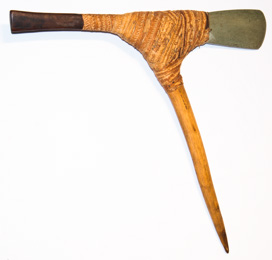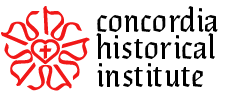October 3, 2014
Artifact: Papua New Guinea Painting

Size: 20 x 24 inches
Date: 1970
Significance: The LCMS began sharing the Gospel with the Enga in the highlands of Papua New Guinea (PNG) in 1948. The mission work grew rapidly in the next decades. The artist, Robert Kroenke, came to PNG as a lay mission builder in 1965 along with his wife, Lois. Robert Kroenke painted numerous portraits of the native New Guineans with whom he came into contact as well as some landscapes. The Kroenkes donated 37 of his paintings to CHI in 2011, and they have served as the inspiration for CHI’s upcoming exhibit on LCMS mission work in Papua New Guinea, which opens this Sunday, October 5.
The Painting: The collection of portraits by Robert Kroenke contained two very similar paintings, both of a man named Kopa rewrapping a stone axe for Kroenke. The painting shown here is not the one in display in the museum. If the two are compared, there are slight differences in the background of the paintings. The prominent feature of this painting’s background is the mountain range, whereas the painting showcased in the exhibit and catalog has native vegetation as the main background element. Below is the artist’s original description of the paintings:
Kopa, another neighbor near Pausa. I bought a stone axe from him. The bark wrapping on it was filthy, and I asked if he would rewrap it for me. He agreed, and I took a photo of him doing that. Many of the axe blades were jade. They chipped them into the rough shape as American Indians did. They rubbed the axe blade across a sandstone block for up to 3 months. . . . Note he is wearing a cloth covering as a yambardi [male apron] with fresh tonket leaves to cover his rear. Wearing these leaves was traditional and they raised those plants near their homes to always have a fresh supply. The leaves would last several days because they were “heavy duty” leaves.
 The traditional stone axe had a handle 18″ to 20″ long. The reason for the pointed end was to easily insert it under their belting to carry them. The piece of wood opposite the blade acted as a shock absorber. While we were there, most used a steel axe that they could buy. The steel head was sharper and far superior to their stone axe heads. The axe came with a handle bigger on the end like we have in the United States. They always shortened and sharpened the handle like the traditional axe handles. Thus each handle had a different feel to it and each man would know his axe from that. As men came to church, they left their axes outside so they poked the handle into the ground and all in a cluster. When asked why they all shaped their axes as they did, they replied, “We always made them that way.” [The axe mentioned above is on display in the CHI exhibit.]
The traditional stone axe had a handle 18″ to 20″ long. The reason for the pointed end was to easily insert it under their belting to carry them. The piece of wood opposite the blade acted as a shock absorber. While we were there, most used a steel axe that they could buy. The steel head was sharper and far superior to their stone axe heads. The axe came with a handle bigger on the end like we have in the United States. They always shortened and sharpened the handle like the traditional axe handles. Thus each handle had a different feel to it and each man would know his axe from that. As men came to church, they left their axes outside so they poked the handle into the ground and all in a cluster. When asked why they all shaped their axes as they did, they replied, “We always made them that way.” [The axe mentioned above is on display in the CHI exhibit.]


